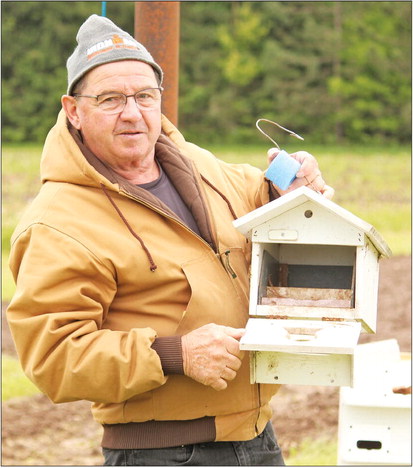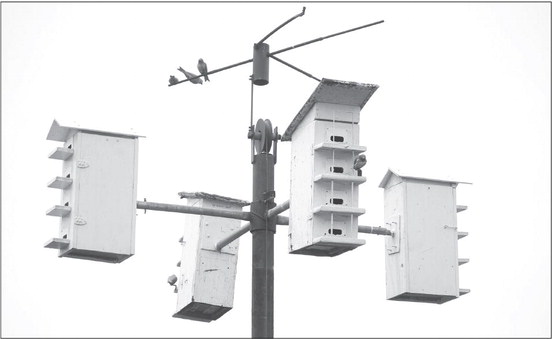QUEST OF A LIFETIME


Halsey resident has spent decades trying to attract purple martins
There are some people who don’t give up. One of them is Clayton Gore.
The town of Halsey resident has had a lifelong fascination with purple martins, the largest bird in the swallow family, and, over decades, he has tried to get one nest in one of the 24 houses he has erected on his Meridian Road property, but, to date, he has not yet succeeded.
Gore refuses to throw in the towel.
The retired dairy farmer erects the white houses on poles each spring, plays a recording of purple martins chirping to attract the birds and shoos away competitors, such as common sparrows and starlings. He even has a video camera trained on the houses and can watch on his living room television set should a purple martin swoop down to nest.
This year, he has seen two purple martins at his property and last year he witnessed five of the birds who checked out the many “apartments” in each elevated house.
“When I see these birds, my heart is in my throat,” he confided. “I think, yes, this is the year when they will stay here.”
Gore has gone to festivals sponsored by the Wisconsin Purple Martin Association, read numerous books, talked with experts and “picked the brains” of local people with the good fortune of attracting purple martins. He continues to try and learn the secret of bringing in martins to stay.
“Purple martins are looking for a safe environment where they can reproduce, but they are very finicky,” he said.
The birds migrate over the winter to South America, as far south as Brazil, said Gore, and return to North America, laying eggs in nests across the eastern and midwest part of the United States and into southern Canada. In Wisconsin, purple martins will return to their nesting ground most often in April or May, but possibly early June. They will stay in Wisconsin for all of 90 days. Once they establish a residence, the birds tend to return to nesting sites year after year.
Gore, 73, started his quest to attract purple martins as a fiveyear- old. He used thin boards from a peach crate obtained from Hartman’s Variety, Athens, to hammer together his first purple martin house. Lacking any kind of electric tool, he sawed the boards by hand and used a hand auger to drill a bird-sized, twoinch hole.
Gore thinks it was his father, Raymond Gore, who likely gave him the notion of attracting purple martins. His interest piqued in the 1950s, when he got to see a large, eight foot by 12 foot purple martin birdhouse in the front yard of one of the Fromm Broth- ers mansions in the town of Hamburg. The structure, one of the biggest purple martin house he has ever seen, was built out of cedar shingles.
Should purple martins ever nest on his property, Gore would be an excellent caretaker. He would use a pulley system to lower the houses, allowing him to check for eggs and for parasitic bugs, such a fly larvae, that would threaten any chicks. Gore said he would remove any pests. He would also make sure that the six-by-12 inch long apartments are properly mudded and furnished with appropriate nesting materials.
Gore thinks that competitors, such as starlings and sparrows, as well as predators, such as hawks and owls, are what have chased away the purple martins that have shown up at his property. The purple martin is not a “fighting bird,” said Gore, and will just move onto a different place if confronted by other birds.
Gore said his son, Mark, who lives south of Marathon City, has inherited his interest in purple martins and, putting up a house, has had several drop by. He knows of a full purple martin house only seven miles from his place.
“I keep thinking that having purple martins is possible,” Gore said.
The purple martin enthusiast maintains his 68-year-old quest even though he knows that should he attract a family of purple martins, there is no guarantee that they would return. Many purple martins die as a result of tropical hurricanes and other severe weather.
“That’s what I believe happened to all of the Edgar purple martins,” he said. “Edgar used to get a lot of purple martins and, then, all of a sudden, none. I think it was a hurricane.”
Gore is able to entertain even wild speculations about why he can’t seem to get purple martins to stay. He wonders, for example, if the satellites he sees pass over his house at night might have something to do with his luck with purple martins.
Gore has burned through several tape players and five or six CD players in his attempt to woo purple martins to his birdhouses with recorded purple martin birdsong. That does not discourage him. “It’s a beautiful bird,” he said. “You can’t see the bird’s colors while in flight. You have to hold the bird in your hands.”

A purple martin

CHEEP HOUSING- Pictured are four of Clayton Gore’s two dozen purple martin houses located on his property in the town of Halsey. The four apartments in each house are designed to be ideal for the birds to raise and protect their young. A pulley system is used to raise and lower the houses. Plastic decoys are used to bring in the purple martins during their migration from South America. Gore also plays purple martin birdsong to attract the species.
